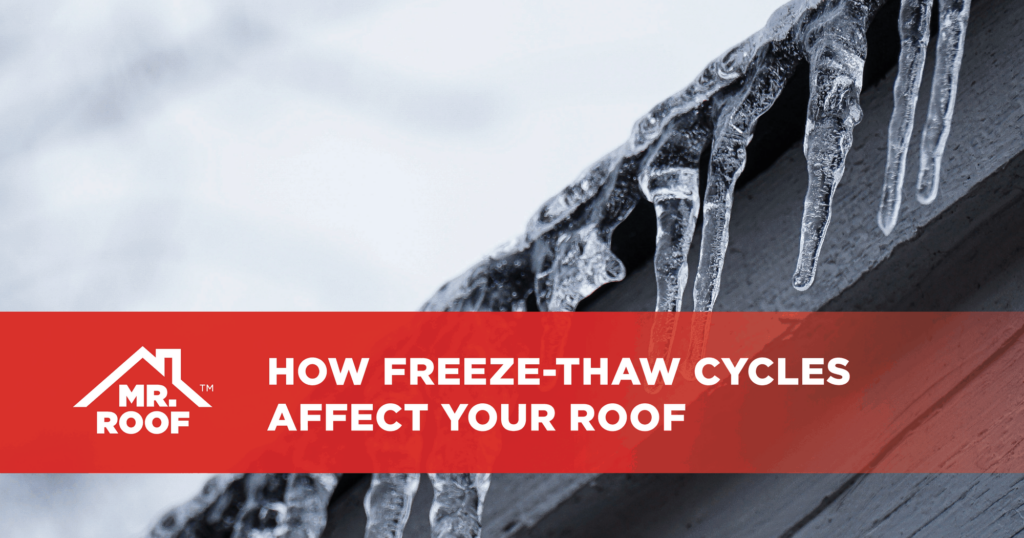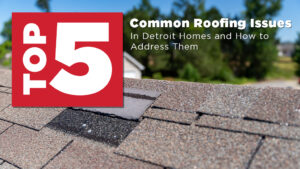Most of us understand basic science concepts whether we explicitly learned them in school or simply encounter them in day-to-day life. You don’t have to be an expert to understand most of these topics, and many times they are so integrated into our daily lives we barely notice how much we know about them. One of these topics is the concept of freezing water. Many of us have ice in our drinking water, use a freezer regularly, or live in an area where winter gets below freezing temperatures. In all of these situations, we have a basic understanding of the science behind water temperatures. As water freezes, it expands. This is why you can’t put cans of sparkling water or soda in the freezer — the expansion of the drink as it freezes will cause the can to explode. If you thaw an ice cube, it contracts and enters its liquid form — water. What many people don’t realize is that this very concept occurs outside naturally, and the effects of it can wreak havoc on your roof.
How freeze-thaw cycles can cause damage
Water and moisture are always in the air. That moisture finds its way into anything it can as a gas or a liquid in the atmosphere. Then, when temperatures drop, the water molecules start to expand. As the water expands, it puts pressure on the object it is inside of. In some cases, like basketballs or plastic buckets, the material that contains the moisture can stretch to accommodate the expansion. However, in things such as concrete or roofing tiles, there is no give in the material to allow it to expand. This means that the freezing water can cause cracks and breakages in the rigid object as it expands. This pressure is created multiple times per week as temperatures rise and fall above and below freezing levels. This cycle puts significant stress on your roof’s shingles and can cause lasting damage.
Signs of roofing freeze-thaw damage
Freeze-thaw cycles can create several problems for your roof, but they don’t all look the same. Here are some signs that your roof is taking a beating from freeze-thaw cycles:
- Uneven or small space between shingles. Shingles should be evenly spaced. If they have moved or seem uneven, the expansion and contraction process has moved them loose.
- Ice Dams. Ice dams happen when the heating on your roof is not uniform or when the freeze-thaw cycle happens with greater frequency. In these instances, snow melts and runs down the roof as water. The water then gets stuck behind shingles and causes pressure beneath the shingles when it freezes again.
- Flashing is out of place. Roofs have metal flashing sheets that seal the cracks on the sides and seams of a roof. If the flashing on your eaves, peak, chimney, etc., has separated from an area, ice dams have likely created damage. These gaps can easily allow further moisture to enter your home and can even cause flooding if not addressed swiftly.
Though these situations can seem frightening, it’s possible to mitigate the damage they cause by addressing the issue early.
Long-term effects of the freeze-thaw cycle
There are other ways in which the freeze-thaw cycle can create long-term damage to your home, investment, and even your family’s health. Here are some long-term effects of the freeze-thaw cycle:
- The freeze-thaw cycle brings moisture under your shingles and into your home. This moisture generally collects in the attic but can spread from there. The water that condenses inside is not clean and brings mold and bacteria with it. As these germs reach the warmth of your home, they are free to grow and spread, causing breathing problems, heightened allergies, and other serious health issues.
- The freeze-thaw cycle speeds up the damage process to your roof. Though all roofs go through wear and tear, if left untreated, the effects of the freeze-thaw cycle could leave you with repairs for which you were not prepared.
- Ice dams easily damage gutters or even remove them from the sides of the roof. When this happens, runoff cannot be directed to the gutters and often pools in your yard or basement.
How to protect your roof
The effects of the freeze-thaw cycle are extreme, and many people stress after discovering what it can do to their home. Fear not. There are steps you can take to protect your roof from significant damage. Follow these steps to protect your home this winter:
- Remove the snow from your roof as soon as you can. Many people call a professional to handle this job safely. This process prevents ice dams.
- If an ice dam has already occurred, call a professional right away to have it removed. The longer you leave it, the more damage you can cause.
- The best thing you can do for your roof in the long term is to make sure that your attic is well ventilated. This airflow keeps the temperature of your roof even and keeps ice from forming.
- Schedule regular roofing inspections. It never hurts to have a professional inspect the state of your roof once or twice a year. If you catch roofing problems early, they are often far easier and less stressful to fix.
Hire a professional
Though technically you can remove ice dams and repair your roof on your own, we really don’t recommend doing so. It is easy to fall and injure yourself or even die when trying to work on a roof without proper equipment and experience. Even ground-based methods such as roof rakes don’t work well and often just create further damage to your shingles. It’s best to call a local, trusted roofer to help you maintain your roof and create a plan for dealing with any issues.
Contact Mr. Roof
For roofers who know all of the ins and outs of the freeze-thaw cycle, contact Mr. Roof. We have been battling ice dams and roofing problems for over 50 years, and there truly isn’t a situation we haven’t seen before. Our number one mission is to give you peace of mind with our craftsmanship and standout customer service. When you hire Mr. Roof, you know that the job will be done correctly and honestly and that the issue was fully resolved. Don’t wait on freeze-thaw cycle issues — call us today.









